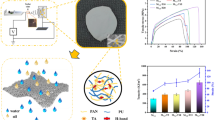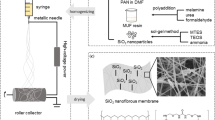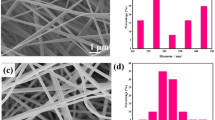Abstract
In this research, an attempt has been made to prepare a membrane with high adsorption capacity and high separation efficiency for oil water. The composite membrane of UiO-66-NH2 and polyacrylonitrile (PAN) were fabricated by electrospinning, and hydrophobic modification was carried out to obtain the oil selectivity. UiO-66-NH2 loaded on fibers significantly enhanced the oil affinity and surface roughness of the composite membrane. The composite membrane was used for colleseed oil, kerosene, methylbenzene, methyl silicone oil and dichloromethane adsorption, and the maximum adsorption capacity were 31.5, 21.9, 19.9, 39.9, 39.7 g·g−1, respectively, which was 32–96% higher than pure PAN adsorbent. The amount of UiO-66-NH2 loaded on fibers accelerated the diffusion of oil in membrane and reduced the adsorption time to reach equilibrium. The adsorption process can be well described by pseudo-second-order and intra-particle diffusion model. The composite membrane also showed potential reusability. In addition, the composite membrane has excellent performance in oil/water separation, and the oil can be separated from mixture solution just under gravity. The oil flux is 2286 Lm−2 h−1 and remains 1568 Lm−2 h−1 after ten times continuous filtration. Overall, the composite PAN-MOFs-coated membrane has promising potential in practical application in oil/water separation.













Similar content being viewed by others
References
Oribayo O, Feng X, Rempel GL, Pan Q (2017) Synthesis of lignin-based polyurethane/graphene oxide foam and its application as an absorbent for oil spill clean-ups and recovery. Chem Eng J 323:191–202
Padaki M, Surya Murali R, Abdullah MS, Misdan N, Moslehyani A, Kassim MA, Hilal N, Ismail AF (2015) Membrane technology enhancement in oil–water separation. A review Desalination 357:197–207
Zhang JQ, Xue QZ, Pan XL, Jin YK, Lu WB, Ding DG, Guo QK (2017) Graphene oxide/polyacrylonitrile fiber hierarchical-structured membrane for ultra-fast microfiltration of oil-water emulsion. Chem Eng J 307:643–649
Fakhru L-Razi A, Pendashteh A, Abdullah LC, Biak DRA, Madaeni SS, Abidin ZZ (2009) Review of technologies for oil and gas produced water treatment. J Hazard Mater 170:530–551
Deschamps G, Caruel H, Borredon M, Bonnin C, Vignoles C (2003) Oil removal from water by selective sorption on hydrophobic cotton fibers. 1. Study of sorption properties and comparison with other cotton Fiber-based sorbents. Environ Sci Technol 37:1013–1015
Wu JY, An AK, Guo JX, Lee E, Farid MU, Jeong S (2017) CNTs reinforced super-hydrophobic-oleophilic electrospun polystyrene oil sorbent for enhanced sorption capacity and reusability. Chem Eng J 314:526–536
Zhang MH, Xin XL, Xiao ZY, Wang RM, Zhang LL, Sun DF (2017) A multi-aromatic hydrocarbon unit induced hydrophobic metal–organic framework for efficient C2/C1 hydrocarbon and oil/water separation. J Mater Chem A 5:1168–1175
Yi XS, Zhu YG, Wang D, Yang F, Wang Y, Shi WX (2018) Adsorption mechanism of oil-in-water on a TiO2/Al2O3–Polyvinylidene fluoride (PVDF) ultrafiltration membrane. Langmuir 34:9907–9916
Shah V, Bharatiya B, Shah DO (2018) Effect of molecular weight and diffusivity on the adsorption of PEO-PPO-PEO block copolymers at PTFE-water and oil-water interfaces. Colloid Polym Sci 296:1333–1340
Kahraman HT, Yar A, Avcı A, Pehlivan E (2018) Preparation of nanoclay incorporated PAN fibers by electrospinning technique and its application for oil and organic solvent absorption. Sep Sci Technol 53:303–311
Kizil S, Bulbul Sonmez H (2016) Investigation of organic solvent/oil sorption capabilities of phenylene-bridged cross-linked poly(alkoxysilane)s. J Polym Res 23:55
Chakraborty A, Bhattacharyya S, Hazra A, Ghosh AC, Maji TK (2016) Post-synthetic metalation in an anionic MOF for efficient catalytic activity and removal of heavy metal ions from aqueous solution. Chem Commun 52:2831–2834
Zhao XL, Liu SL, Tang Z, Niu HY, Cai YQ, Meng W, Wu FC, Giesy JP (2015) Synthesis of magnetic metal-organic framework (MOF) for efficient removal of organic dyes from water. Sci Rep 5:1–10
Wen J, Fang Y, Zeng GM (2018) Progress and prospect of adsorptive removal of heavy metal ions from aqueous solution using metal–organic frameworks: a review of studies from the last decade. Chemosphere 201:627–643
Hou YB, Xu ZM, Yuan Y, Liu LX, Ma SC, Wang W, Hu Y, Hu W, Gui Z (2019) Nanosized bimetal-organic frameworks as robust coating for multi-functional flexible polyurethane foam: rapid oil-absorption and excellent fire safety. Compos Sci Technol 177:66–72
Gu JH, Fan HW, Li CX, Caro J, Meng H (2019) Robust superhydrophobic/superoleophilic wrinkled microspherical MOF@rGO composites for efficient oil-water separation. Angew Chem Int Ed 58:5297–5301
Gao ML, Zhao SY, Chen ZY, Liu L, Han ZB (2019) Superhydrophobic/superoleophilic MOF composites for oil-water separation. Inorg Chem 58:2261–2264
Li H, Zhu L, Zhang JQ, Guo TC, Li X, Xing W, Xue QZ (2019) High-efficiency separation performance of oil-water emulsions of polyacrylonitrile nanofibrous membrane decorated with metal-organic frameworks. Appl Surf Sci 476:61–69
Zhu HT, Qiu SS, Jiang W, Wu DX, Zhang CY (2011) Evaluation of electrospun polyvinyl chloride/polystyrene fibers as sorbent materials for oil spill cleanup. Environ Sci Technol 45:4527–4531
Wang CH, Liu C, Li JS, Sun XY, Shen JY, Han WQ, Wang LJ (2017) Electrospun metal–organic framework derived hierarchical carbon nanofibers with high performance for supercapacitors. Chem Commun 53:1751–1754
Zhang CL, Lu BR, Cao FH, Wu ZY, Zhang W, Cong HP, Yu SH (2019) Electrospun metal-organic framework nanoparticle fibers and their derived electrocatalysts for oxygen reduction reaction. Nano Energy 55:226–233
Efome JE, Rana D, Matsuura T, Lan CQ (2018) Metal–organic frameworks supported on nanofibers to remove heavy metals. J Mater Chem A 6:4550–4555
DeCoste JB, Peterson GW, Jasuja H, Glover TG, Huang Y, Walton KS (2013) Stability and degradation mechanisms of metal-organic frameworks containing the Zr6O4(OH)4 secondary building unit. J Mater Chem A 1:5642–5650
Xu YM, Japip S, Chung TS (2018) Mixed matrix membranes with nano-sized functional UiO-66-type MOFs embedded in 6FDA-HAB/DABA polyimide for dehydration of C1-C3 alcohols via pervaporation. J Membrane Sci 549:217–226
Efome JE, Rana D, Matsuura T, Lan CQ (2018) Insight studies on metal-organic framework nanofibrous membrane adsorption and activation for heavy metal ions removal from aqueous solution. Acs Appl Mater Inter 10:18619–18629
Yin YY, Li H, Zhu L, Guo TC, Li X, Xing W, Xue QZ (2019) A durable mesh decorated with polydopamine/graphene oxide for highly efficient oil/water mixture separation. Appl Surf Sci 479:351–359
Bhardwaj N, Kundu SC (2010) Electrospinning: a fascinating fiber fabrication technique. Biotechnol Adv 28:325–347
Eda G, Shivkumar S (2006) Bead structure variations during electrospinning of polystyrene. J Mater Sci 41:5704–5708
Fong H, Chun I, Reneker DH (1999) Beaded nanofibers formed during electrospinning. Polymer 40:4585–4592
Zhang L, Aboagye A, Kelkar A, Lai C, Fong H (2014) A review: carbon nanofibers from electrospun polyacrylonitrile and their applications. J Mater Sci 49:463–480
Habiba U, Afifi AM, Salleh A, Ang BC (2017) Chitosan/(polyvinyl alcohol)/zeolite electrospun composite nanofibrous membrane for adsorption of Cr6+, Fe3+ and Ni2+. J Hazard Mater 322:182–194
He JH, Wan YQ, Yu JY (2008) Effect of concentration on electrospun polyacrylonitrile (PAN) nanofibers. The Korean Fiber Society, Heidelberg, pp 140–142
Lee MW, An S, Latthe SS, Lee C, Hong S, Yoon SS (2013) Electrospun polystyrene nanofiber membrane with superhydrophobicity and superoleophilicity for selective separation of water and low viscous oil. Acs Appl Mater Inter 5:10597–10604
Wang P, Chen MJ, Han HL, Fan XL, Liu Q, Wang JF (2016) Transparent and abrasion-resistant superhydrophobic coating with robust self-cleaning function in either air or oil. J Mater Chem A 4:7869–7874
Lai FL, Huang YP, Zuo LZ, Gu HH, Miao YE, Liu TX (2016) Electrospun nanofiber-supported carbon aerogel as a versatile platform toward asymmetric supercapacitors. J Mater Chem A 4:15861–15869
Yin N, Wang K, Wang LZ, Li ZQ (2016) Amino-functionalized MOFs combining ceramic membrane ultrafiltration for Pb (II) removal. Chem Eng J 306:619–628
Yin N, Wang K, Xia YA, Li ZQ (2018) Novel melamine modified metal-organic frameworks for remarkably high removal of heavy metal Pb (II). Desalination 430:120–127
Cai Y, Li J, Yi LM, Yan XJ, Li JW (2018) Fabricating superhydrophobic and oleophobic surface with silica nanoparticles modified by silanes and environment-friendly fluorinated chemicals. Appl Surf Sci 450:102–111
Liao Y, Wang R, Fane AG (2013) Engineering superhydrophobic surface on poly(vinylidene fluoride) nanofiber membranes for direct contact membrane distillation. J Membrane Sci 440:77–87
Ma WJ, Zhao JT, Oderinde O, Han JQ, Liu ZC, Gao BH, Xiong RH, Zhang QL, Jiang SH, Huang CB (2018) Durable superhydrophobic and superoleophilic electrospun nanofibrous membrane for oil-water emulsion separation. J Colloid Interf Sci 532:12–23
Cao JL, Su YL, Liu YN, Guan JY, He MR, Zhang RN, Jiang ZY (2018) Self-assembled MOF membranes with underwater superoleophobicity for oil/water separation. J Membrane Sci 566:268–277
Wenzel RN (1936) Resistance of solid surfaces to wetting by water. Industrial & Engineering Chemistry 28:988–994
Lin KA, Yang H, Petit C, Hsu F (2014) Removing oil droplets from water using a copper-based metal organic frameworks. Chem Eng J 249:293–230
Wu J, Wang N, Wang L, Dong H, Zhao Y, Jiang L (2012) Electrospun porous structure fibrous film with high oil adsorption capacity. Acs Appl Mater Inter 4:3207–3212
Gao JF, Li B, Wang L, Huang XW, Xue HG (2018) Flexible membranes with a hierarchical nanofiber/microsphere structure for oil adsorption and oil/water separation. J Ind Eng Chem 68:416–424
Johnson RF, Manjreker TG, Halligan JE (1973) Removal of oil from water surfaces by sorption on unstructured fibers. Environ Sci Technol 7:439–443
Wan WC, Zhang RY, Li W, Liu H, Lin YH, Li L, Zhou Y (2016) Graphene–carbon nanotube aerogel as an ultra-light, compressible and recyclable highly efficient absorbent for oil and dyes. Environmental Science: Nano 3:107–113
Acknowledgements
Financial support for the work is coming from Hunan Science and Technology Project (2017WK2019). The authors will thank Professor Tai-Shung Chung from National University of Singapore for learning in his group and Hui Guo for his help in electrospinning.
Author information
Authors and Affiliations
Corresponding author
Additional information
Publisher’s note
Springer Nature remains neutral with regard to jurisdictional claims in published maps and institutional affiliations.
Rights and permissions
About this article
Cite this article
Chen, Y., Jiang, L. Incorporation of UiO-66-NH2 into modified PAN nanofibers to enhance adsorption capacity and selectivity for oil removal. J Polym Res 27, 69 (2020). https://doi.org/10.1007/s10965-020-2035-7
Received:
Accepted:
Published:
DOI: https://doi.org/10.1007/s10965-020-2035-7




